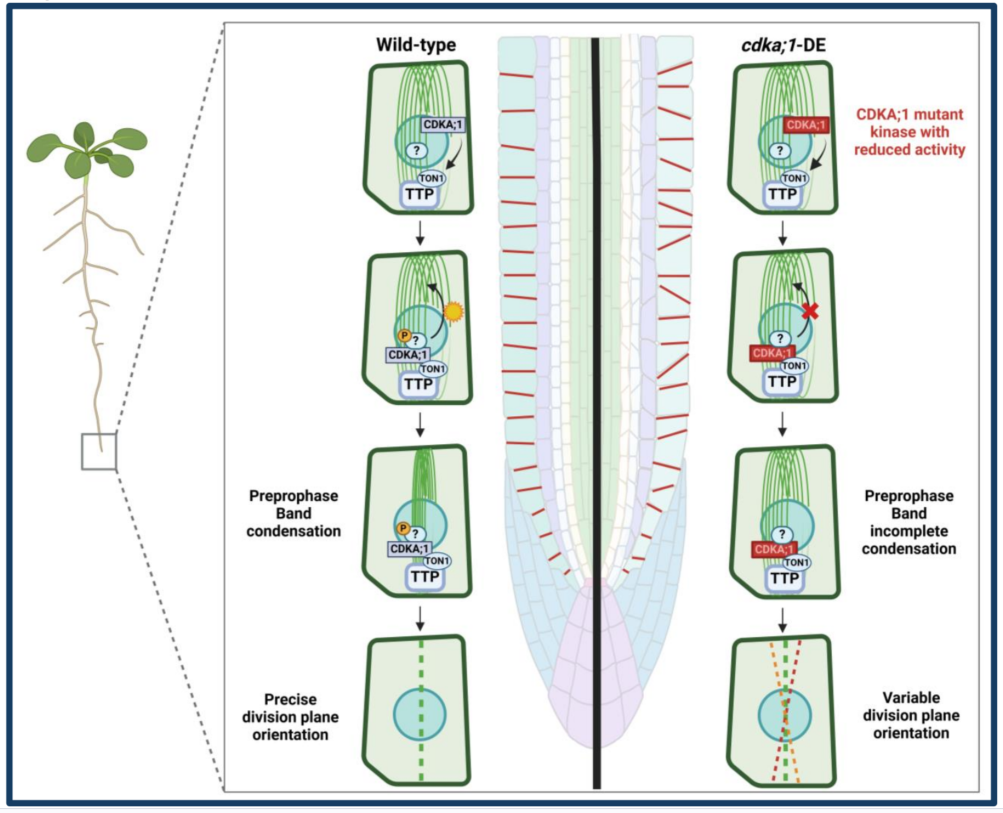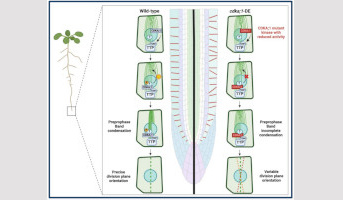Rith Théa Hak awardee of the GS Biosphera for his Master 2 internship
Rith Théa Hakn, Agronomist Engineer from AgroParisTech and a PhD student in the "Spatial Control of Cell Division" SPACE team, is a recipient of the "Plant Sciences" thematic program of the Graduate School Biosphera for his Master 2 thesis abstract in "Integrative Biology and Physiology, "Plant Sciences" track, Université Paris-Saclay, Research pathway. Rith first discovered the work of the SPACE team during a mini-internship while he was a first-year engineering student at AgroParisTech (equivalent to Bachelor’s level, year 3) during the "Immersion in Research integration module" of the "Research & Me" scheme in June 2021. The video of his oral presentation on his internship project with the SPACE team will be showcased during the Scientific Day of the GS Biosphera on Thursday, November 28, 2024.
Master 2: Cell cycle and cytoskeleton crosstalks for mitotic entry in plant cells
Plant morphogenesis heavily rely on cell division, thus requiring spatiotemporal regulation. While the cell cycle machinery orchestrates the timing and sequence of events leading to mitosis, the microtubule cytoskeleton can organize into 3D arrays, allowing spatial regulation of the cellular events at play. However, the crosstalk between cell cycle and cytoskeleton has yet to be elucidated1. The aim of my internship was to start deciphering the main aspects of these interactions. In particular, we focused on the Preprophase Band (PPB), a ring-like structure of microtubules arrays formed at the cell cortex prior to mitotic entry. The PPB regulates the division plane orientation and its formation requires the TON1/TRM/PP2A (TTP) protein complex that can interact with cortical microtubules1. Interestingly, Cyclin-Dependent Kinase A;1 (CDKA;1), the central cell cycle regulator was observed at the PPB shortly before its disassembly2, raising the following questions: Is CDKA;1 involved in PPB disassembly? Is it recruited there by the TTP complex? To address these questions, I used genetics and microscopybased approaches in the root meristem of Arabidopsis thaliana. First, I characterized localization dynamics of CDKA;1 tagged with a fluorescent protein. In contradiction with previous works, I showed that CDKA;1 accumulates at the PPB at the beginning of its formation and not only upon its disassembly, suggesting another role than in its dismantlement. Then, CDKA;1 activity implication in PPB regulation was assessed using the cdka;1-DE hypomorphic mutant3. Immunolocalization with cell walls and microtubules staining was performed. PPB defects can be assessed by measuring angles formed by transverse cell walls of adjacent cells and a reference in the root as a good proxy of division orientation. Strikingly, division angles are very regular in wild-type, but were more variable in the mutant. Accordingly, microtubules staining revealed that the mutant presents wider PPBs, indicating a maturation defect, as PPBs usually condense as they mature. To further dig into molecular mechanisms, we studied CDKA;1 interaction with the TTP complex. In fact, CDKA;1 colocalizes with TTP proteins such as TRM7 and TON1 at the PPB and Bimolecular Fluorescence Complementation (BiFC) assays revealed that CDKA;1 can physically interact with TON1. Besides, expression of the CDKA;1 fluorescent marker in ton1, a PPB-devoid mutant, no longer displays any localization at the cortex of the cell. Overall, it suggests that CDKA;1 is recruited at the PPB through its interaction with TON1 and cannot localize at the cortex alone. Following this work, it is of particular interest to identify CDKA;1 targets at the PPB and phospho-regulation sites thanks to phosphoproteomics, which might help better understand the mechanisms leading to the formation of this peculiar ring.
References
1 Motta MR, Schnittger A (2021) A microtubule perspective on plant cell division. Current Biology 31: 547-552
2 Weingartner M, Binarova P, Drykova D, Schweighofer A, David JP, et al. (2001) Dynamic recruitment of Cdc2 to specific
microtubule structures during mitosis. Plant Cell 13:1929-43
3 Dissmeyer N, Weimer AK, Pusch S, De Schutter K, Alvim Kamei CL, et al. (2009) Control of cell proliferation, organ growth, and
DNA damage response operate independently of dephosphorylation of the Arabidopsis Cdk1 homolog CDKA;1. Plant Cell
21:3641-54

Legend: Central cell cycle regulator CDKA;1 is involved in preprophase band maturation. CDKA;1 is recruited at the PPB shortly
after its formation by TON1. There, it supposedly phosphorylates an unknown player that triggers PPB condensation. Thus, fully
matured PPB allows precise division plane orientation setup.
Research developed at the Institute Jean-Pierre Bourgin for Plant Sciences.
Master 2: Cell cycle and cytoskeleton crosstalks for mitotic entry in plant cells
Plant morphogenesis heavily rely on cell division, thus requiring spatiotemporal regulation. While the cell cycle machinery orchestrates the timing and sequence of events leading to mitosis, the microtubule cytoskeleton can organize into 3D arrays, allowing spatial regulation of the cellular events at play. However, the crosstalk between cell cycle and cytoskeleton has yet to be elucidated1. The aim of my internship was to start deciphering the main aspects of these interactions. In particular, we focused on the Preprophase Band (PPB), a ring-like structure of microtubules arrays formed at the cell cortex prior to mitotic entry. The PPB regulates the division plane orientation and its formation requires the TON1/TRM/PP2A (TTP) protein complex that can interact with cortical microtubules1. Interestingly, Cyclin-Dependent Kinase A;1 (CDKA;1), the central cell cycle regulator was observed at the PPB shortly before its disassembly2, raising the following questions: Is CDKA;1 involved in PPB disassembly? Is it recruited there by the TTP complex? To address these questions, I used genetics and microscopybased approaches in the root meristem of Arabidopsis thaliana. First, I characterized localization dynamics of CDKA;1 tagged with a fluorescent protein. In contradiction with previous works, I showed that CDKA;1 accumulates at the PPB at the beginning of its formation and not only upon its disassembly, suggesting another role than in its dismantlement. Then, CDKA;1 activity implication in PPB regulation was assessed using the cdka;1-DE hypomorphic mutant3. Immunolocalization with cell walls and microtubules staining was performed. PPB defects can be assessed by measuring angles formed by transverse cell walls of adjacent cells and a reference in the root as a good proxy of division orientation. Strikingly, division angles are very regular in wild-type, but were more variable in the mutant. Accordingly, microtubules staining revealed that the mutant presents wider PPBs, indicating a maturation defect, as PPBs usually condense as they mature. To further dig into molecular mechanisms, we studied CDKA;1 interaction with the TTP complex. In fact, CDKA;1 colocalizes with TTP proteins such as TRM7 and TON1 at the PPB and Bimolecular Fluorescence Complementation (BiFC) assays revealed that CDKA;1 can physically interact with TON1. Besides, expression of the CDKA;1 fluorescent marker in ton1, a PPB-devoid mutant, no longer displays any localization at the cortex of the cell. Overall, it suggests that CDKA;1 is recruited at the PPB through its interaction with TON1 and cannot localize at the cortex alone. Following this work, it is of particular interest to identify CDKA;1 targets at the PPB and phospho-regulation sites thanks to phosphoproteomics, which might help better understand the mechanisms leading to the formation of this peculiar ring.
References
1 Motta MR, Schnittger A (2021) A microtubule perspective on plant cell division. Current Biology 31: 547-552
2 Weingartner M, Binarova P, Drykova D, Schweighofer A, David JP, et al. (2001) Dynamic recruitment of Cdc2 to specific
microtubule structures during mitosis. Plant Cell 13:1929-43
3 Dissmeyer N, Weimer AK, Pusch S, De Schutter K, Alvim Kamei CL, et al. (2009) Control of cell proliferation, organ growth, and
DNA damage response operate independently of dephosphorylation of the Arabidopsis Cdk1 homolog CDKA;1. Plant Cell
21:3641-54

Legend: Central cell cycle regulator CDKA;1 is involved in preprophase band maturation. CDKA;1 is recruited at the PPB shortly
after its formation by TON1. There, it supposedly phosphorylates an unknown player that triggers PPB condensation. Thus, fully
matured PPB allows precise division plane orientation setup.
Research developed at the Institute Jean-Pierre Bourgin for Plant Sciences.
Back
